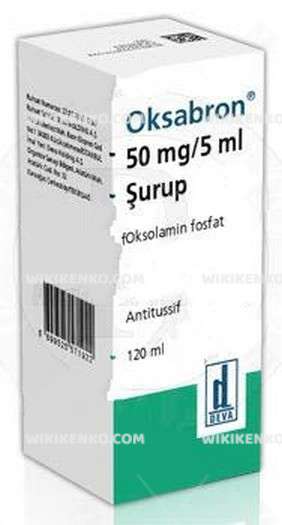Oksabron Syrup
In the realm of cough relief, Oksabron Syrup emerges as a beacon of hope. This comprehensive guide unveils the mysteries of Oksabron, from its composition to applications, precautions, potential side effects, and crucial drug interactions. Join us as we navigate the medicinal landscape of this cough suppressant.
| Dosage form | |
|---|---|
| Pack size | |
| Potency | 50 Mg/5Ml 120Ml |
| Manufacturer | |
| Origin | |
| Generic Name (Ingredient) | 35.5 Mg Equivalent Of Oxolamine Base, Contains 50 Mg Of O2Olamine Phosphate. |
Assuming your emergency circumstances for this product, visit Urgent Quotation page. Besides, for any pharmaceutical questions, please ask us in the comments section.
Description
Oksabron Syrup, a cough suppressant with predominantly peripheral action, offers solace to those troubled by non-productive coughs. At its core lies the potent active ingredient, oxolamine phosphate, which orchestrates its therapeutic symphony.
Indications for Use
Oksabron Syrup finds its calling in addressing a spectrum of respiratory ailments. It serves as a trusted companion in:
- Coughs accompanying colds and upper respiratory tract infections.
- Upper and lower respiratory tract conditions such as rhinosinusitis, pharyngitis, laryngitis, tracheitis, acute bronchitis, bronchopneumonia, COPD, flu, and the common cold.
Oksabron Syrup Dosage
The path to optimal relief with Oksabron is personalized, with daily doses spanning from 200-800 mg, administered twice a day. For patients with impaired renal function (creatinine clearance 20-50 ml/min), the initial dose is 200 mg, followed by 100 mg every 24 hours.
Prudent Precautions
Before embarking on an Oksabron Syrup regimen, cautious considerations are paramount:
- Allergy Alert: Oksabron is off-limits if you exhibit allergies to any of its constituents.
- Age Matters: This syrup is reserved for those aged 6 and above.
- Gastric Comfort: To mitigate potential side effects, it’s advisable to consume Oksabron after meals. Diluting the syrup with an equal part of water often serves as a shield against side effects.
While Oksabron Syrup’s therapeutic landscape is promising, vigilance remains the watchword. Possible side effects encompass a spectrum, including:
- Nausea
- Vomiting
- Diarrhea
- Abdominal pain and cramps
- Appetite loss
- Dry mouth
- Flatulence
- Gastrointestinal dysfunction
- Constipation
In rare instances, it might tread into more treacherous territory, manifesting as liver damage, liver necrosis, jaundice, hepatitis, intestinal perforation, pseudomembranous colitis, or gastrointestinal bleeding.
Interactions
Oksabron Syrup’s interactions with other substances can chart unexpected courses. Notable interactions include:
- Antacids containing calcium, magnesium, or aluminum, as well as sucralfate and preparations rich in two-and trivalent cations like iron or multivitamins containing zinc. These can potentially impair quinolone absorption.
- NSAIDs, which elevate the risk of central nervous system stimulation and seizures.
- Theophylline, known to increase its concentration in blood plasma, thus extending its half-life. This amplifies the likelihood of adverse reactions linked to theophylline action.
Contraindications and Considerations
Oksabron Syrup carves out its path with specific contraindications. It should be refrained from if you possess allergies to any of its components. Moreover, its usage is not recommended for children below the age of 6. As with any medication, thorough consultation with a healthcare provider is imperative before commencing treatment, ensuring alignment with your unique health profile. Remember, this information may not be exhaustive, and undisclosed contraindications might exist.
Pregnancy and Breastfeeding
The journey of Oksabron Syrup during pregnancy or breastfeeding should be guided by medical counsel. The potential risks and rewards must be carefully weighed with the assistance of a healthcare provider. It’s worth noting that medication exposure through breast milk carries the highest risk for premature infants, newborns, and medically unstable infants or those with impaired kidney function. A healthcare provider’s insights are invaluable in making informed decisions for the well-being of both mother and child.
At a glance
| Property | Details |
|---|---|
| Active Ingredient | Oxolamine phosphate |
| Indications for Use | – Coughs accompanying colds and upper respiratory tract infections<br>- Various upper and lower respiratory tract conditions |
| Dosage | Individualized daily doses ranging from 200-800 mg, administered twice daily. Adjusted for renal impairment. |
| Precautions | – Allergies to components<br>- Age below 6 years<br>- Consumption after meals<br>- Dilution with water |
| Side Effects | A spectrum including nausea, vomiting, diarrhea, abdominal pain, appetite loss, dry mouth, flatulence, gastrointestinal dysfunction, constipation. Rare instances of severe effects such as liver damage, jaundice, and gastrointestinal bleeding. |
| Interactions | – Interaction with antacids, sucralfate, and certain cations affecting quinolone absorption.<br>- Elevated risks with NSAIDs and theophylline. |
| Contraindications | Allergies to components and age below 6 years. |
| Pregnancy and Breastfeeding | Decision guided by healthcare provider due to potential risks and benefits. Careful consideration for infant health. |
In Conclusion
Oksabron Syrup, fortified with oxolamine phosphate, stands as a versatile ally against a myriad of respiratory challenges. Yet, it’s not a journey to embark on alone. Consultation with a healthcare provider is the compass that ensures a safe and effective course. Understanding its interactions and contraindications adds another layer of security. Remember, in the realm of healthcare, knowledge is the key to well-informed decisions
Use the form below to report an error
Please answer the questions as thoroughly and accurately as possible. Your answers will help us better understand what kind of mistakes happen, why and where they happen, and in the end the purpose is to build a better archive to guide researchers and professionals around the world.
The information on this page is not intended to be a substitute for professional medical advice, diagnosis, or treatment. always seek the advice for your physician or another qualified health provider with any questions you may have regarding a medical condition. Always remember to
- Ask your own doctor for medical advice.
- Names, brands, and dosage may differ between countries.
- When not feeling well, or experiencing side effects always contact your own doctor.
Cyberchondria
The truth is that when we’re sick, or worried about getting sick, the internet won’t help.
According to Wikipedia, cyberchondria is a mental disorder consisting in the desire to independently make a diagnosis based on the symptoms of diseases described on Internet sites.
Why you can't look for symptoms on the Internet
If diagnoses could be made simply from a textbook or an article on a website, we would all be doctors and treat ourselves. Nothing can replace the experience and knowledge of specially trained people. As in any field, in medicine there are unscrupulous specialists, differences of opinion, inaccurate diagnoses and incorrect test results.



Reviews
There are no reviews yet.